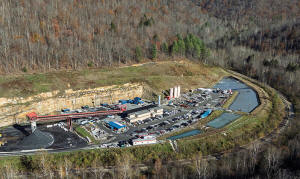The body of a coal miner has been found in a flooded West Virginia mine,
the governor says
[November 14, 2025]
By JOHN RABY
CHARLESTON, W.Va. (AP) — The body of a coal miner was found early
Thursday in a mine that flooded in southern West Virginia, Gov. Patrick
Morrisey said.
Machines had been pumping water out of Alpha Metallurgical Resources
Inc.’s Rolling Thunder Mine near Belva, about 50 miles (80 kilometers)
east of the state capital of Charleston. The water receded enough for
rescue crews to safely enter Thursday morning, and they found foreman
Steve Lipscomb dead less than two hours later, Morrisey said in a
statement.
Morrisey praised the crews who worked around the clock for days in hopes
of a rescue.
“Our state knows this kind of pain all too well,” Morrisey said. “Mining
is more than an industry here — it’s a brotherhood, a way of life, and a
source of pride. When tragedy strikes, we grieve together, we stand
together, and we support one another as one West Virginia family.”
A mining crew hit an unknown pocket of water on Saturday about
three-quarters of a mile (1.2 kilometers) into the mine, which flooded
after an old mine wall “was compromised,” Morrisey said. More than a
dozen other miners were accounted for after the accident was reported.
Lipscomb was last seen trying to make sure his crew got out of the mine
safely, Alpha said in a statement.

“Our hearts are broken,” Alpha CEO Andy Eidson said.
Lipscomb, 42, of Elkview, joined Alpha in 2006 and “was a dedicated
employee, respected leader and friend to many,” Eidson said. “His
actions to ensure the safety of his crew members were heroic. On behalf
of the entire organization, we extend our prayers and deepest sympathies
to his wife, two children and all who knew and cared for him.”
Lipscomb, whose body was taken to a medical examiner Thursday afternoon,
received a Purple Heart as a Marine and is survived by his wife and two
teenage children, Morrisey said at a briefing Thursday night.
Lipscomb’s death is the seventh U.S. coal mining fatality this year and
the third at an Alpha facility in West Virginia. The others occurred in
nearby Raleigh County: An elevator being tested struck a miner on a
first-floor platform in August at Alpha subsidiary Marfork Coal’s
processing facility; and a coal seam fell on a contractor in February at
Alpha’s Black Eagle underground operation, according to the U.S. Mine
Safety and Health Administration.
[to top of second column]
|

The Rolling Thunder coal mine near Swiss, in Nicholas County, West
Virginia, is seen in this aerial photo on Wednesday, Nov. 12, 2025.
(Sean McCallister/Charleston Gazette-Mail via AP)

At Rolling Thunder, holes were drilled in the mine in an attempt to
speed up the search process and dive teams explored potential areas
in the water where air pockets might exist. The National Cave Rescue
Commission provided surplus Army phones attached to wires that can
travel great distances for better underground communication.
Rolling Thunder is one of 11 underground mines operated in West
Virginia by Tennessee-based Alpha, which also operates four surface
mines in the state, as well as three underground mines and one
surface mine in Virginia.
Morrisey said the abandoned mine next to Rolling Thunder had been in
operation in the 1930s and 1940s.
A report prepared in February for Alpha by an engineering consulting
firm, Marshall Miller & Associates, said the area had been
“extensively explored” by previous mine owners, generating “a
significant amount of historical data” that Alpha examined in
assessing its potential for producing coal.
The same report says the Rolling Thunder coal seam runs along and
below the drainage of Twentymile Creek, but that there were “no
significant hydrologic concerns” about digging for coal in the
extensively mined property.
In 1968, in the same county, miners working for Gauley Coal and Coke
at Hominy Falls accidentally tunneled into an unmapped abandoned
mine nearby, flooding their operation. Four men died, but 15 miners
were brought to the surface after five days, and six others further
into the mine were rescued after 10 days.
In 2002 in southwestern Pennsylvania, nine miners were rescued after
spending more than three days trapped in the flooded Quecreek Mine.
All contents © copyright 2025 Associated Press. All rights reserved
 |